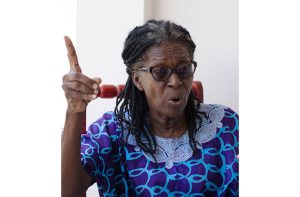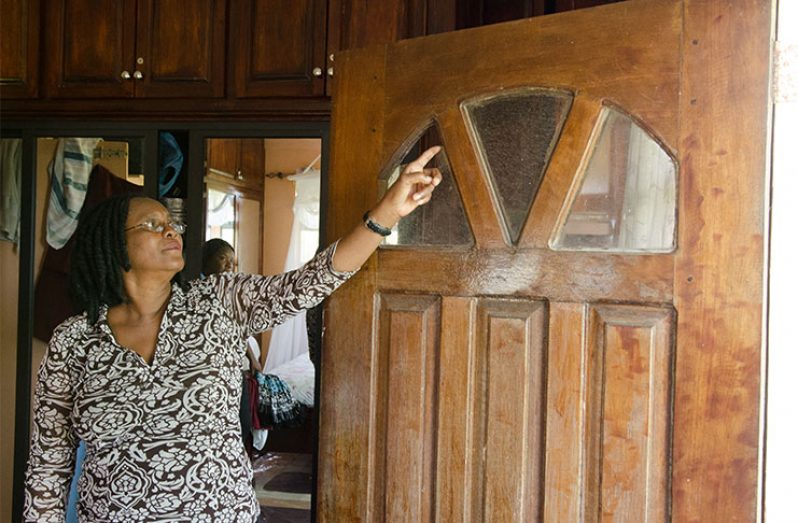…Buxton mothers still seeking justice years after sons, daughters were killed
“IT was a terrifying period,” 68-year-old Yvette Herod said as she painfully walked the Guyana Chronicle down memory lane to a time when bullets fell like rain in Buxton-Friendship, neighnouring villages on the East Coast of Demerara (ECD) and other parts of the country.
That period spanned from 2000 to 2009 and even beyond when dead bodies were removed almost daily from the streets of not only in Buxton-Friendship, but across the country. In its wake there were three massacres: Lusignan– where 11 people were killed; Bartica — where another 12 were killed; and Lindo Creek — where eight miners were slaughtered. And though there was no ‘Buxton Massacre,’ it was there that residents witnessed countless extra-judicial killings of mainly Afro-Guyanese males.
BUXTON WAS A WAR ZONE
 In the early 2000s when criminal elements and police wreaked havoc, Herod, a resident of Buxton-Friendship, was the Headmistress at the New Friendship Nursery School. “Buxton was a war zone, and as the headteacher, it was my duty to protect those children,” she said while detailing that on a daily basis residents of the village were subject to gun fights, extra-judicial killings, raids, constant patrols by the police and army, and even police harassment. “We don’t know who brought criminal elements in here, we are not saying that Buxton is innocent of all things but we did not bring criminal elements in here. We did not bring any criminal elements in here,” Herod told the Guyana Chronicle.
In the early 2000s when criminal elements and police wreaked havoc, Herod, a resident of Buxton-Friendship, was the Headmistress at the New Friendship Nursery School. “Buxton was a war zone, and as the headteacher, it was my duty to protect those children,” she said while detailing that on a daily basis residents of the village were subject to gun fights, extra-judicial killings, raids, constant patrols by the police and army, and even police harassment. “We don’t know who brought criminal elements in here, we are not saying that Buxton is innocent of all things but we did not bring criminal elements in here. We did not bring any criminal elements in here,” Herod told the Guyana Chronicle.
GUN DRILLS FOR KIDS
Left with no other choice, the three, four, and five year-old children attending the New Friendship Nursery School underwent ‘gun-drills’ – a practice of the emergency procedures to be used in case of shootings.
“We would take a piece of wood, and position it like a gun, pointing to the air, as though we were firing off shots – pow, pow, pow – and then we would say, when you hear that hit the floor, hit the floor. So when they heard POW, one; POW, two, they would hit the floor,” Herod explained. The nursery school children, she said, were taught to lie on the ground whenever there is a shooting, and to remain there until they were told to get up.
The now retired headteacher explained that it was important to teach the children what should be done during a shooting, whether in school, on the road or at home, in order to keep them safe. In many cases, the Education Ministry, ordered New Friendship Nursery School and other schools in the area closed.
“When these guns start firing, we would call the Education Ministry and tell them that there is a shootout in the village, and they would say to us, once that is happening, make sure that the children are safe and when it is possible you just close the school,” Herod explained.
Parents would often rush to the schools, whenever there was an exchange of gunfire, to collect their children. “Whenever we had these shootouts between the police and these criminal elements, parents would rush to the school and take their children home because that would happen, sometimes, whole day. Sometimes you have gun shots whole day, whole night,” she explained.
CAUGHT IN THE CROSS FIRE
It was on such a day, that one of Herod’s sisters was shot dead in a cross fire. Donna, a mother of nine, was 47-years-old when she was gunned down in full view of two of her younger children at the time. She was killed in September 2007, a short distance away from the New Friendship Nursery School in Buxton-Friendship, during what the Guyana Human Rights Association described as an ill-conceived, badly executed and poorly led police operation to flush out criminals from the East Coast Demerara village.
“I was retired then but I was at home sleeping but what I understood is that she came from work and as usual, when the guns started firing, she went there (at the nursery school) to collect her son,” Herod explained. She said based on information gathered, her other sister collected Donna’s son and walked up the ‘line’, while Donna and two of her other children walked in the opposite direction through the street that is in close proximity to both the nursery and primary schools. It was while walking through the street that Donna was shot.
“After the gunshots ceased, they started pulling her, calling on her to get up. They continued to pull at her, and the guns started firing again. And so some boys who were working at a house nearby, after they were crying, the boys ran out and grabbed them,” Herod reported.
Evelyn Estwick and Donna Herod were friends at the time. They had gone to the nursery school to pick up their children, and like Donna and her sister, they went in opposition direction. “I went up to the ‘line,’ and when I went up to the ‘line,’ the police were there, and I said: sir excuse me, nobody ain’t firing at all yuh, this is a nursery school, let we get home with these children but this man watch me, like when you see a ghost,” Estwick recalled.
It was not long after, that gunshots started ringing out. “Girl I throw myself towards the trench, and I put my granddaughter to lie down, and I lie down over her. Girl, like I get weak, and when the shooting stopped, I ran to put my granddaughter in the house, and by the time I meet at the bridge, I hear hollering at Brushe Dam, the girl done get hit, and lie down dead,” Estwick recounted.
“The girl lie down dead on the road and her child haversack hang around her, and her two children crying, two children,” Estwick said as her eyes well up with tears. “It was a time that I don’t ever want to come back. It could have been me, because we left the school together,” she added.
Residents that had witnessed the shooting had laid the blame at the feet of the police but the late Henry Greene, who was the Commissioner of Police (ag) at the time had denied the allegation. Donna’s death was never thoroughly investigated and to date those responsible were never brought to justice.
WHERE IS JOSLYN JONES?
At the time of Donna’s death, Estwick was still grappling with the fact that her nephew Joslyn Jones disappeared in May, 2004 after he was seen in police custody. Jones, 27, at the time, had lived with his aunt at her Friendship residence. He had lived with her since as a child after the death of his parents. On the day he disappeared, Estwick had left him home with one of her granddaughters, and had warned him not to venture into the city – Georgetown – to purchase the boots he was eager to buy. But though he agreed not to leave the house, Jones took the baby to Estwick’s father and made his way to Georgetown. He had promised Estwick’s father to return shortly but was never seen since.
“When I got home, I called Joslyn’s phone. I called it, it ring out,” Estwick recalled while noting that it was unusual for him not to answer his cell home.
Before daybreak the next day, Estwick was informed that Jones was in the vicinity of DEMICO when he was “picked up” by the police and taken to the Brickdam Police Station. She and other relatives rushed to the station but were told that no Joslyn Jones was in custody or had been arrested. “While waiting, two boys came out. So the boys said: lady who you looking for, I said, I am looking for my nephew Joslyn, and I started describing him,” she recalled.
“They said that boy got picked up with we, and they bring he at the station, and then the boy carried him back but we ain’t know where they go with he,” the grieving aunt further recalled.
Estwick said shortly after her nephew’s disappearance, the snow cone man who was standing with him at the time he was taken into custody, gave the police a statement. The snow cone man, according to reports, indicated that he could have identified the police officers that took Jones into custody. At the time of the reported arrest, Jones was wearing his aunt’s jewellery, and had the boots he had purchased.
According to Estwick, after the matter was taken before the then Police Commissioner Henry Greene, little was heard of the investigation. “I never saw my nephew back. Never, never, never,” Estwick said as she broke down in tears. She had turned to the court. “I did all what I could have done. I did all what I could have done. You ever do til you can’t do any more. I went I took a lawyer, because I said somebody must tell me something,” she said. His death remains a mystery to this day.
NO MORE PPP
Another resident, who requested anonymity, blamed the People’s Progressive Party/Civic (PPP/C) Administration at the time, for the crimes. The crimes, between 2003 and 2006, were linked to convicted drug-trafficker Shaheed Roger Khan, who had set up a criminal network here, including active policemen and a number of former ranks, ostensibly to go after criminals, but at the same time protecting his narco-trafficking interests. “We aren’t asking, we know that we will get a re-visitation of the past anytime this government change because this time they will come after us. They will come to spite us, and we do not deserve it, we do not deserve it,” the woman said.
She recalled that during the crime wave, many families would pool their financial resources together to send their male relatives to the islands, US, and other countries. “It was a sad time, and they had to leave because they were being targeted, our black brothers, uncles and fathers were targeted, and so families thought it best to send them away lest they turn up dead,” the elderly woman said.
The Buxtonian and Friendship women that spoke to the Guyana Chronicle on Sunday endorsed the call for President David Granger to launch immediately, an investigation into the extra-judicial killings that occurred under the Bharrat Jagdeo Administration, and for Roger Khan to be arrested upon his deportation to Guyana. The Executive of Mourning Families and Friends in White – a committee of the Ghana Day Organisation – are demanding that the intellectual authors of the state-sponsored murders, as well as their hired assassins, be brought to justice.



.jpg)








